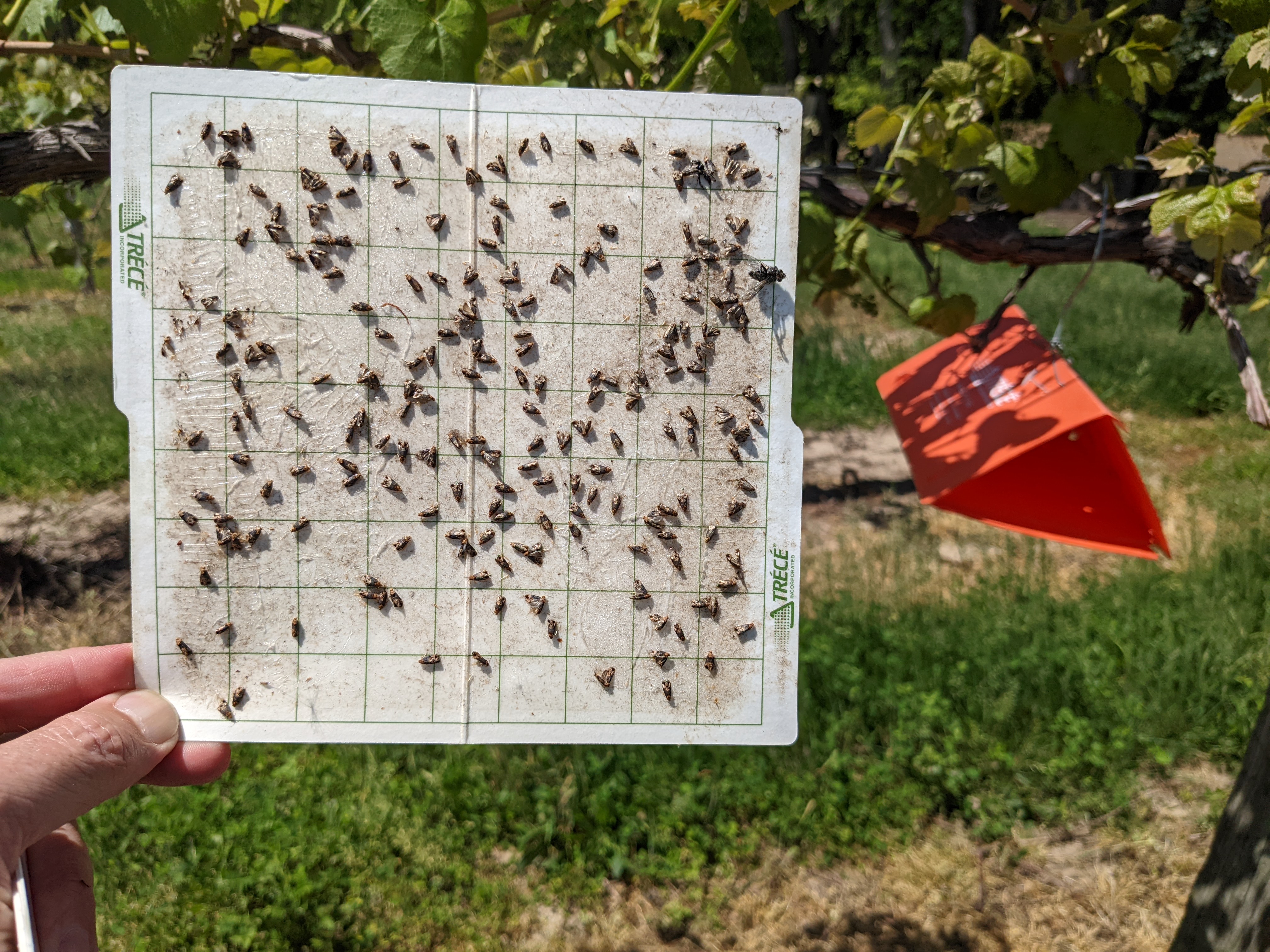Early season control of grape berry moth in Michigan vineyards for 2022
Adjusting strategies for different vineyards is essential.

As vineyards progress through the bloom period of development this spring, focus on insect pest control increases. Grape berry moth (GBM) is a key insect that must be managed in Michigan vineyards. Most management programs target later generations, but under the right circumstances management of the first generation now might be a worthwhile endeavor. Infestation by this pest is highly variable, with some vineyards having low pest pressure and others that were severely affected in 2021. There is a general pattern each year of lower pressure going north, with some sites in southwest Michigan having hundreds of moths per week in traps and over 50% of clusters affected at harvest-time last year, whereas vineyards in the northwest growing region did not catch a moth all season resulting in no infestation.
Making recommendations across this range of risk to grape berry moth is a challenge. This article has been developed to help growers and consultants tailor management to these varying situations.
Monitoring and scouting

To understand GBM pest pressure across the farm and to avoid the recent late-season surprises that have affected some vineyards in recent years, it is important to use monitoring traps and to check clusters regularly. This can be done in previous hot spots on the farm (usually near adjacent woods or near trees or buildings) to see if your management program is working. This spring at sites that had a lot of GBM infestation last year, we have seen a very high emergence of GBM moths with hundreds per trap indicating that they survived the winter well under the snow. Other vineyards have less than 10 in the traps all spring.
Sites with the highest activity are now showing some GBM larvae starting to form webbing in the clusters. This is easily scouted for by walking along a wooded edge where there were host-spots last season. A sample of 100 clusters can tell you what % cluster infestation is present. Through the season, this approach can be repeated at areas around the farm to track GBM development. Selecting some different sites at vineyard edges and interiors can provide a view of this pest across your farm.
A need for first generation control?
Previous trials in Michigan have indicated that sprays for the second and third generations of GBM are most effective at reducing harvest-time infestation. This is still the foundation of how best to protect from this insect and will work well for most vineyards that do not have very high pressure. Our degree day model is developed to improve timing of sprays for that part of the season. Future articles this year will highlight how to approach second and third generation control using timings based on the timing of wild grape bloom (seen over the last few weeks in southwest Michigan).
We are, however, seeing very high GBM moth activity at some vineyard sites in southwest Michigan, and the first larvae of GBM were found in this week’s scouting at farms in Lawton. At locations where there were problems with GBM last year, control of the larvae of this first generation should be considered and a working threshold of 5% clusters infested can be used to guide the decision to treat or not.
Controlling early-season GBM larvae
A wide range of insecticides registered for control of GBM are available for commercial grape growers. These vary in their properties from B.t. products such as Javelin and Dipel and the insect growth regulator Intrepid that all have little disruption to beneficial insects to the highly broad spectrum pyrethroids such as Danitol, Baythroid and Mustang Maxx. Early in the year, it is worth considering the beneficials since they can work for you through the rest of the season.
There is a column in a table in the Michigan State University Extension Fruit Management Guide and in the MSU Grape Insecticide Rankings table that shows the relative risk to beneficials of different insecticide options. Consider a long-lasting residual and selective insecticide such as Intrepid to cover the clusters in hot spots through the bloom and post-bloom period.
The immediate post-bloom timing of Concord vines typically lines up with the peak of activity by GBM larvae, so if a fungicide application is being timed then and scouting indicates cluster infestation by GBM is building, this can be an efficient timing for an insecticide to control the first generation of this pest.
When considering product selection, efficacy and price are primary drivers. The MSU Grape Insecticide Rankings table provides an overview of relative efficacy for insecticides registered in vineyards. The applications should be set up to ensure good coverage of the clusters. Consider a spreader to ensure penetration into the nooks and crannies of the young cluster.
A note on resistance
A current research project at MSU is comparing sensitivity of GBM moths to key insecticide classes at vineyards where control has been less effective than growers were used to. The results show some variation in sensitivity between farms, but not a dramatic change. The results also indicate that field-applied rates should remain highly effective. Populations with lower sensitivity might have a shorter residual period of activity as the residues decline. The study results highlight the importance of not relying on one chemical class, and instead rotating the classes through the season. See the table provided for details on which insecticides are in which class.
There is an excellent grape crop developing for Michigan in 2022, so pest management will be important for being able to harvest all of those clusters. In places with GBM problems in 2021, maintaining protection through this season will also require coverage of the second and third generation, and a follow-up article in late June will focus on this time of the season.



 Print
Print Email
Email



